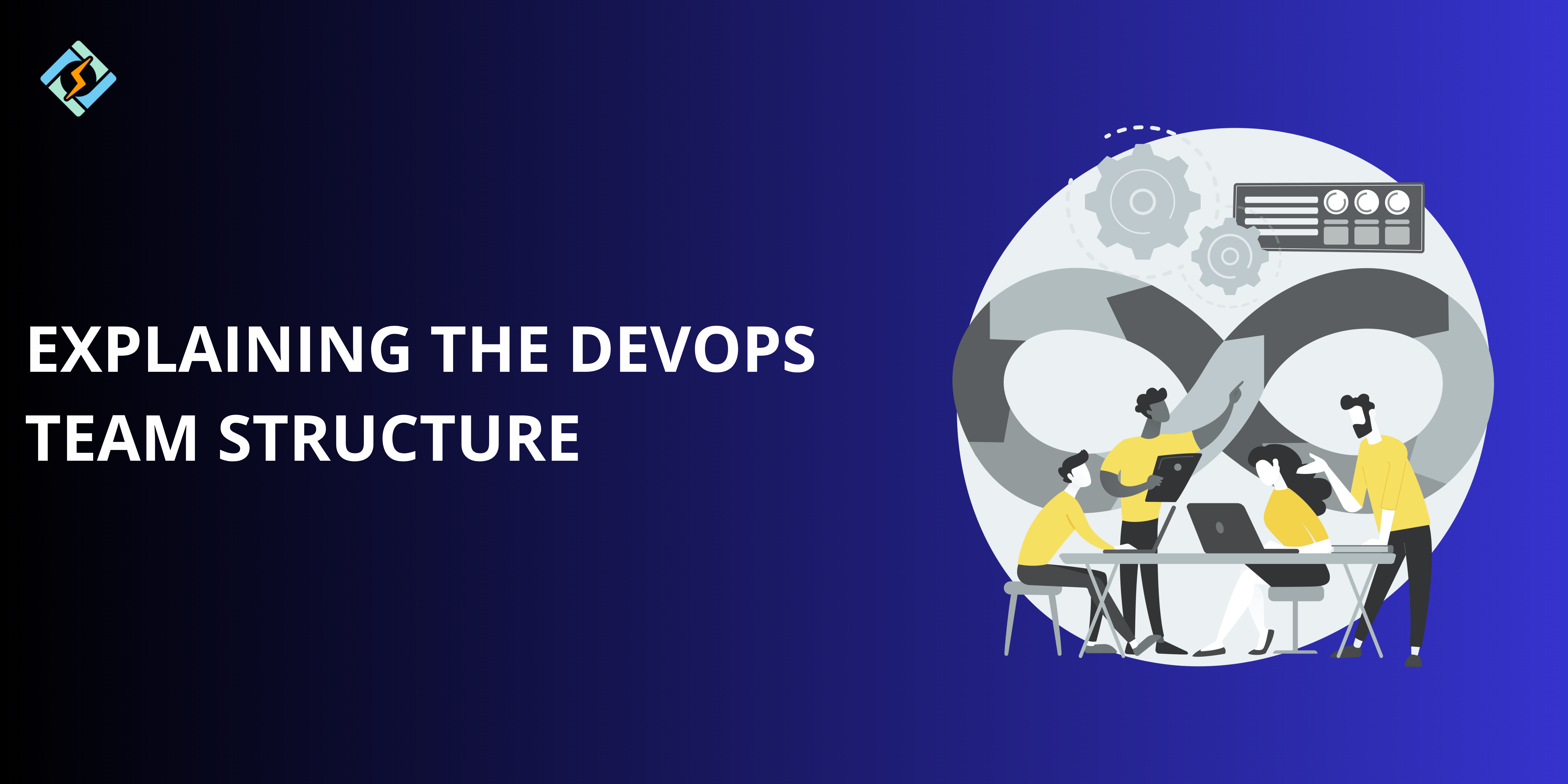DevOps is not a buzzword but a practice that transforms software development, testing, deployment, and operation. DevOps only promotes cross-functional collaboration between development (Dev) and operations (Ops) teams by removing the conventional silos to promote efficiency, velocity, and software quality. More than 99% of the organizations adopting DevOps are experiencing benefits such as higher product quality, shorter development cycles, and lower lead times, as per a study done by Atlassian. DevOps can be purely effective, though, only when proper team structure is present within organizations. In this guide, we’ll explore the fundamentals of a DevOps team structure, its benefits, best practices for structuring a DevOps team, and different DevOps team models that can be adopted based on an organization’s needs.
What is a DevOps Team?

A DevOps team is a cross-functional group of engineers, IT professionals, and operation staff working together to automate software deployment. Unlike a general IT organization, DevOps teams are responsible for the entire application life cycle from development and testing to deployment and monitoring.
Rather than having dedicated software development and IT operations teams, a DevOps team structure encompasses both. Continuous integration, deployment, and feedback loops result in quicker releases and enhanced reliability.
Main Features of a DevOps Team
- Collaboration – DevOps breaks silos across teams so there is communication and collective responsibility.
- Automation – Monitoring, deployment, and testing are automated to increase efficiency.
- Continuous Improvement – The processes are constantly improved to be able to run better software.
- Shared Responsibility – Both developers and operations engineers share the task of running and optimizing the apps.
Benefits of an Organized DevOps Team
An organized DevOps team structure has a number of benefits that make an organization’s process of software development enhanced.
Faster Development and Deployment
DevOps accelerates software deployment by eliminating the obstacles between development and operations. New features, patches, and fixes can be released faster, which means fewer days to market.
Improved Collaboration and Communication
There is greater visibility across departments because there is a DevOps team hierarchy. Developers, operation engineers, and QA testers communicate better with each other, handoffs are more seamless, and there are fewer misunderstandings.
Get exclusive access to all things tech-savvy, and be the first to receive
the latest updates directly in your inbox.
Stable Software
DevOps supports continuous testing and monitoring, and therefore fewer bugs and stable software. Continuous integration (CI) and automated tests catch bugs early.
Better Security
Embedding security practices (DevSecOps) in development allows organizations to find vulnerabilities in the development phase than after deployment, reducing security breaches.
Lower Expenditure
Automation and continuous monitoring lower human effort and operational costs, and therefore DevOps is an expense-saving method of software development.
Important Things to Keep in Mind When Developing a DevOps Team
It is not about recruiting more engineers when creating a successful DevOps team. It is also about transforming current team infrastructures, communications, and business goals. DevOps success also depends on skills, which is why many organizations invest in DevOps certification training to build expertise, stay updated with tools, and enhance cross-functional collaboration.
- Retention Instead of Recruitment
While fresh ideas come through the hiring of fresh DevOps engineers, retraining and assimilating the existing employees also has to be done. Unloading present employees, well acquainted with company culture and working habits, of their work turns out to be economical on the recruitment side and leads to better-integrated teams. - Cross-Functional Team Methodology
Instead of dividing into operation, testing, UI/UX, and development teams, the DevOps team needs to be cross-functional so that they possess a mix of skill sets. This way, everything gets addressed at the initial stage. - Leadership and Culture
DevOps promotes shared responsibility, collaboration, and trust by culture. There needs to be leadership with clear communications, information sharing, and a continuous improvement mindset. - Clearly Defined Roles
While co-working is the core of DevOps, there must be defined roles for every member in the team so that there is no confusion. Some of the fashionable DevOps positions are:
- DevOps Engineer – Automates the process, orchestrates the infrastructure, and keeps CI/CD pipelines updated regularly.
- Site Reliability Engineer (SRE) – Performs performance monitoring and incident management.
- Security Engineer – Implements security in DevOps operations.
- Release Manager – Manages deployment procedures of the software.
- Communication
Internal and external communication channels must work between the DevOps teams. Daily stand-up, common documents between all members, and communication tools like Slack or Microsoft Teams can make it transparent.
DevOps Team Structures: Models and Approaches
There is not a single, solitary DevOps team organizational design. The optimal organizing will depend on the organization’s size, complexity, and business needs. Some of the most common DevOps team organizational structures are examined below.
1. Development and Operations Team Coordination
This is the lowest-level DevOps plan, where the existing development and operations teams collaborate very closely but not integrated. They maintain different jobs but are aligned through regular meetups, identical KPIs, and identical workflows.
Best for
- Legacy to DevOps transformation companies
- Role-separation preferring companies
Issues
- Has to have effective communication to avoid misalignment
- Has the potential to be a little friction-causing between teams from time to time
2. Fully Integrated DevOps Team (NoOps)
Development and operations are here combined. Developers undertake monitoring, deployment, and maintenance, eliminating the need for the traditional operations team.
Best for
- Serverless app and tech start-ups
- Serverless computing and microservices dedicated companies
Issues
- Too much responsibility for developers to both develop and infrastructure
- Has high automation demands
3. Site Reliability Engineering (SRE) Model
Made famous by Google, the SRE model uses a staff of experienced professionals who are solely accountable for software reliability. Developers create software, and the SRE team handles performance, security, and uptime.
Best for
- Large enterprises’ intricate infrastructure
- Those which have reliability and scalability as high priorities
Issues
- Needs more training and resources
- Can slow down development if not properly managed
4. Platform Engineering Team (Infrastructure as a Service)
In this model, there is a specialized DevOps or platform engineering team that provides infrastructure, automation, and CI/CD pipelines as a service to several development teams.
Best for
- Large organizations with numerous development teams
- Organizations that need a centralized DevOps team
Issues
- Becomes bottlenecks if the platform team is small
- Becomes the goat for dependency problems if not well-defined
5. External DevOps Team or Consulting Model
Others have hired a third-party DevOps team to implement best practices, deploy tools, and train internal personnel. That’s only a temporary measure until the business develops its own DevOps culture.

Best for
- New DevOps businesses that require guidance
- Bodies that need specialist skills
Issues
- Dependence on external consultants
- May entail a cultural shift to keep DevOps practices in-house
Best Practices for Managing a DevOps Team
An effective and cross-functional DevOps team needs to be worked on continuously. Follow these best practices:
- Utilize Value Stream Mapping
Value stream mapping allows teams to map processes visually, uncover bottlenecks, and streamline processes to make them efficient by simplifying them. - Automate Everything
From infrastructure provisioning to CI/CD pipelines, automation is the key to gaining development speed without errors. - Implement Blameless Culture
Fostering a culture in which failure is realized to be a learning experience enhances problem-solving and innovation. - Real-Time Monitoring and Feedback
Use Prometheus, Grafana, and ELK Stack for monitoring system performance and offering high availability. - Upgrade and Ongoing Training
DevOps is an ever-evolving industry. Ask employees to acquire new skills and enhance themselves with novel tools and techniques.
Final Thoughts
The success of a DevOps team is based on organization and integration into an organization as a success. Whether it is done through a collaborative process, an SRE process, or a NoOps team integrated whole, the only thing that will matter in the end is creating a culture of collaboration, automation, and continuous improvement.
With the optimal DevOps team structure and best practices, businesses can release software quicker, get it more reliable, and all in all, provide more value to their consumers.
Ready to revolutionize your DevOps process? The ideal team structure may be your pot of gold!
FAQs
1. What is a DevOps Team Structure?
A DevOps team structure outlines how development and operations teams work together to automate the software development lifecycle (SDLC). It dismantles departmental silos, encouraging continuous integration, delivery, and automation to enhance speed, quality, and reliability.
2. Why is DevOps Team Structure Important?
A well-organized DevOps team enhances collaboration, decreases time to market, and enhances software stability. It guarantees that developers, testers, and operations collaborate together with joint responsibilities, resulting in continuous improvement as well as quicker deployment cycles.
3. What is the Difference Between DevOps and Agile?
Although both are concerned with quicker software delivery, they vary in reach:
Agile: Mainly concerned with iterative development and interaction between developers and stakeholders.
DevOps: Expands Agile concepts to encompass operations, focusing on automation, continuous delivery, and infrastructure management.



